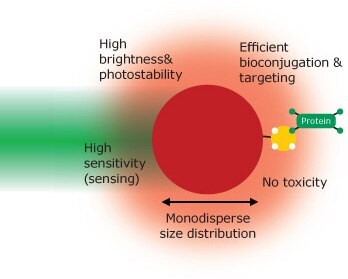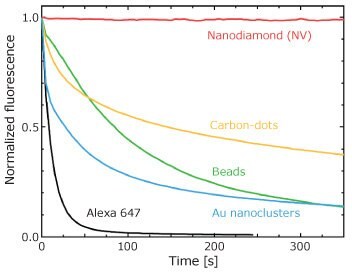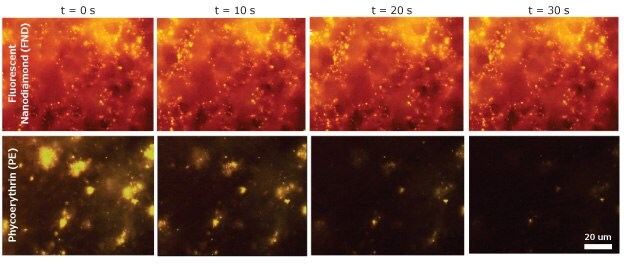Fluorescent Nanomaterials for Bioimaging: Considerations of Particle Brightness, Photostability, and Size
Philipp Reineck1, Marco Torelli,2
1RMIT University, 2Adámas Nanotechnologies, Inc.,
Material Matters, 2019, 14.2
Introduction
Fluorescence microscopy has become an essential component of many biological studies, affecting everything from fundamental research to clinical diagnostics. In contrast to other imaging methods such as electron microscopy, computed tomography, and ultrasound, fluorescence microscopy combines high spatial resolution with targeted, multispectral contrast.1,2 While organic fluorophores and fluorescent proteins are vital tools in biology and biotechnology laboratories today, other fluorescent nanomaterials are increasingly being used in research laboratories around the world, in applications ranging from deep tissue imaging in vivo3,4 to point-of-care diagnostics.5 In contrast to the majority of organic fluorophores, which are under 1 nm in size, nanomaterials range from 1–100 nm in size, allowing them to act as discrete entities with a loadable surface. Fluorescent nanomaterials have achieved success in a variety of applications because of their beneficial capabilities which enable:
- High optical contrast in otherwise contrast-free samples
- Visualization or detection of specific components of complex biological systems
- Visualization of structures at high spatial and temporal resolutions — well below 100 nm size and millisecond timescales
- Quantification of physical (temperature, magnetic fields, strain) and biochemical properties (pH, concentration of molecules and ions) down to the subcellular level
- Delivery of payloads in accord with targeting
Considering these benefits, an ‘ideal’ nanoparticle is shown in Figure 1. This ideal material would show high fluorescence brightness with high uniformity across different particles, no photo-bleaching, perfect biocompatibility, and highly selective binding to, or detection of, the specific analyte of interest. While these attributes are desirable in most applications, the ideal size of a nanomaterial strongly depends on the application and size of the objects of interest. While the perfect nanoparticle does not yet exist, great advancements have been made in the field. In this article, we will review current state-of-the-art materials, with an emphasis on fluorescence brightness, photostability, and size, and relate them to emerging applications.

The properties of an ‘ideal’ fluorescent nanomaterial.
Brightness
Fluorescence brightness is a vital property of every fluorescent nanomaterial. Sufficient fluorescence brightness is critical to show a signal against the often autofluorescent background found in biological systems. The fluorescence brightness, B, is generally defined as the product of absorption coefficient (ε) and quantum yield (Γ): B = ε Γ. A bright material must emit absorbed excitation light efficiently, i.e. it must have a high fluorescence quantum yield. It must also absorb photons efficiently, which is to say it needs a high absorption coefficient. The latter is often quantified in terms of moles, for example [M-1cm-1], meaning that the physical size of the material is not taken into account. However, size is an important parameter. Organic dyes are usually about 1 nm in diameter, about 10 to 100 times smaller than most fluorescent nanoparticles. A semiconductor-based quantum dot (QD) may absorb light 10 times more efficiently than an organic dye, but its volume is also often more than 100 times larger! Therefore, the answer to the question “Which material is brighter?”, often rests on whether the comparison is made based on molecule/particle numbers (and a molar extinction coefficient) or on the materials’ mass (and a mass-based extinction coefficient).6 These two measures of brightness are compared for six different types of nanomaterials in Table 1. The molar brightness of molecular fluorophores like fluorescein and green fluorescent protein (GFP) is surpassed by several materials. However, due to the small size of molecules like fluorescein, their mass brightness exceeds those of other molecules more than an order of magnitude.
A single 100 nm nanodiamond or 10 nm polymer dot exceeds the brightness of a fluorescein molecule by more than one order of magnitude, but at the cost of a larger particle size. However, larger particles are not always bad, and sometimes even required from a biological standpoint — for example to evade immediate clearance in an in vivo experiment. The detection of rare events, where the unambiguous detection of individual particles is paramount, can also be enhanced by the extremely high molar brightness of larger particles (also see section on ‘Size’). Generally, mass brightness is skewed towards small and low-density materials; for example carbon dots exhibit a reasonable mass brightness, but their molar brightness is much less than that of other materials. Molar brightness has its origin in the world of molecules, and ignores the size of nanoparticles. Practically, selecting the most meaningful measure of brightness depends on the specific particle and application of interest.
In general, organic dyes absorb light very efficiently, because the entire molecule interacts with light through delocalized electrons. Nanodiamonds, on the other hand, mostly consist of a transparent diamond matrix, which only contains about 0.001% by weight of so-called “color centers,” like nitrogen-vacancy (NV) centers, which absorb light and fluoresce.7 Hence, the potential for improvement is enormous. The extinction and brightness of semiconductor quantum dots and polymer dots increases with their increasing size.8,9 Nanodiamonds are one of the few materials whose brightness has the potential to be increased significantly by improving the quality of NV centers. Work is in progress to develop gentle methods of micron-sized particle fragmentation or use bottom-up synthesis of particles containing NV centers.10
Photostability
Most applications involve multiple cycles of nanomaterial excitation and collection of the fluorescence signal. Even in the simplest in vitro cellular imaging experiment, when only a few images are required, finding a region of interest usually requires at least several seconds of light excitation. Therefore, photostability is an important parameter — the brightest
fluorescent material is useless if the intensity fades too quickly. This phenomenon of fading is called “photobleaching.”
The physiochemical changes involved in the process of photobleaching are often complex, highly material specific, and
highly dependent on the local environment and the intensity of light excitation used. Many materials can exhibit either high or low photostability, depending on the particular environment and illumination intensity used. This partially explains the lack of quantitative information on the photostability of fluorescent nanomaterials in the scientific literature. Some widely known and used fluorophores, such as fluorescein, have been investigated in great detail,16,17 but most newer materials have not.
Two common measures of photostability are 1) absolute or lifetime photostability — the average number of photons a fluorophore can emit before becoming inactive and 2) photobleaching rate — the decrease in fluorescence intensity per
unit of time. Absolute photostability is independent of excitation intensity over a wide range, but is experimentally challenging
to measure. The photobleaching rate can be determined more readily, but is highly dependent on illumination intensity.
The fluorescence intensity as a function of time for several fluorescent nanomaterials suspended in water and imaged under a commercial wide-field fluorescence microscope is shown in Figure 2.4 Illumination intensities on the order of 10 W cm-2 were used, which are very moderate relative to the excitation intensities commonly used in confocal microscopy (10–100 W cm-2), up conversion nanoparticle imaging (100–1000 W cm-2),18 and stimulated emission depletion super-resolution imaging (>1000 W cm-2).19 For example, Alexa 647 is a common red fluorophore that shows a characteristic photobleaching time (the inverse of the photobleaching rate) of about 8 seconds under these conditions. In contrast, nanodiamonds show no photobleaching at all, and drift in the excitation intensity is actually the highest source of variability. All other materials show photobleaching characteristics between these two extremes. In practice, brightness and photostability are closely related: a brighter material can be excited at lower light intensities and thus achieve the same image contrast as a less bright fluorophore. Therefore, the appropriate measure of photostability is also application dependent. Figure 2 only shows one possible scenario, where equal excitation intensities are used.
Size of Fluorescent Nanoprobes
Nanomaterial size is an important parameter that largely determines how a biological system interacts with the exogenous material. Size affects both active and passive cell uptake, active and passive transport processes, immune system responses, clearance pathways, and toxicity, to name some important examples.20 It also plays an important part in physical and chemical processes including diffusion, ionic interactions, and chemical bond formation. As with the previous characteristics, ideal particle size strongly depends on the application.

Figure 2.Photostability of several fluorescent nanomaterials in a widefield fluorescence microscopy experiment. All materials were dispersed in deionized water and illuminated with excitation intensity of ~10 W cm-2. Reproduced with permission from reference 6, copyright 2016 Wiley.
In complex biological environments such as blood, serum, or even growth media, the formation of a protein corona makes the determination of the nanoparticle size highly non-trivial.20,21
Table 2 summarizes some general considerations regarding the suitability of nanomaterials in particular size ranges for different applications and research requirements. In order to investigate the dynamics of a system, the size of the fluorescent nanomaterial being used relative to the objects involved in the process must be considered. For example, in order to study the dynamics of individual molecules, only the smallest fluorescent labels can be employed, since the inertia of larger nanoparticles will interfere with or even halt entirely most of these processes. On the other hand, if intracellular transport along microtubules is the focus of the inquiry, nanoparticles up to tens of nanometers may be a good choice, since individual nanoparticles can provide higher contrast (and therefore potentially higher temporal resolution) and higher photostability. Eukaryotic cells routinely transport larger objects such as vesicles and parts of organelles via motor proteins, and a 30 nm nanoparticle may only have a minor effect on the transport dynamics.22 Moreover, size can directly influence the cellular uptake of particles.23
In experiments in vivo, the interactions are often even more complex and less well-understood. In fact, there is agreement in the scientific community on only a few aspects of nanomaterial size effects. Renal clearance of nanomaterials generally requires a hydrodynamic radius (including adsorbed biological species) below 5.5 nm.24 Particles up to ~200 nm are cleared by the liver, while larger particles are filtered by the spleen.25 Particles on the order of ~150 nm are thought to be optimal to avoid clearance by the spleen and increase targeting potential due to their longer circulation time.26

Figure 3. Time-lapse of blood clots incubated with a biotinylated platelet activation antibody (anti-CD41-biotin), incubated with streptavidin conjugated to either fluorescent nanodiamond (top) or phycoerythrin (PE) (bottom). PE quickly degrades, while the fluorescent nanodiamond (FNDs) signal remains constant.
Applications
One current application of photostable fluorophores is to follow biological phenomena over time via long-term imaging.27 This can allow cell tracking28 and whole organism imaging over several days.29 Figure 3 exemplifies how quickly the image quality can degrade at high magnification in an imaging experiment. While an initial image set is collected, it is fundamentally difficult to make fine adjustments to the field of view focus without sacrificing image quality. Emission in the near infrared (NIR) regime is also a critical factor for in vivo imaging.30-31 Many nanomaterials (including quantum dots and nanodiamonds) have emission in the near-infrared (NIR). Potential in vivo32 clinical applications include fluorescence image-guided surgery, when bleaching of the tumor marker can be suppressed.32 The brightness of the tumor marker at tissue penetrating wavelengths is a critical factor for in vivo imaging.
Photostable nanomaterials are particularly important in emerging applications using high laser intensities, where photobleaching is a critical limiting factor. For instance, nanodiamond can withstand over 100 MW cm-2 intensity without bleaching.34 In super-resolution imaging, which allows for image resolutions below the diffraction limit, photostability has both direct and indirect effects. Directly, fluorophores often need to withstand high excitation intensities for extended periods of time. Indirectly, since the resolution in stimulated emission depletion (STED) microscopy generally increases with increasing excitation power, the more photo stable a material is better.35 Fundamentally, resolution is limited by the size of the particle,36 though it is possible to image individual NV centers with resolution down to 6 nm.37 Being able to withstand high laser intensities, nanodiamonds allow the highest possible image resolution.38 In stochastic optical reconstruction microscopy (STORM) though not directly adding to cellular contrast, nanodiamonds serve as fiducial markers to correct for stage drift, thereby routinely allowing the acquisition of images with 10 nm resolution39 (with as low as 2.6 nm40 demonstrated) and up to 26 multiplex rounds — unprecedented for a superresolution technique.40
In multiphoton microscopy, high resolution fluorescence images can be acquired as deep as hundreds of microns below the surface tissue. Multiphoton excitation enables tight focusing of light inside tissue, and allows for optical cross-sectioning and a reduction in background fluorescence.41-42 While the excitation area may be reduced, high local laser intensities in the focal spot still cause photobleaching.43-44 Two-photon excitation has been used to image fluorescent nanodiamond (FND) in MCF-7 breast cancer cells (at 800 nm excitation)45 and HeLa cells, demonstrating a large contrast increase by reducing the background fluoresence.46-47 For in vitro use, visualization of particles down to 40 nm in size has been shown.47 In these examples, under high illumination conditions (up to 3 GW cm-2 and up to 10 min), no bleaching for two-photon emission was observed.46,48
Although we have highlighted examples where photostable materials shine, photobleaching itself can be used as an imaging technique. Historically, techniques such as fluorescence recovery after photobleaching (FRAP) has been used to determine molecular diffusion rates. Recently, photobleaching-assisted STORM improved the achievable signal-to-noise ratio of this technique, which is particularly useful for analytes with extremely high autofluorescence.49 Moreover, photobleaching itself can be used as a contrast mechanism to allow for multiplexed imaging, when the different photobleaching times of various dyes can be used to provide contrast in a signal channel.50
Fluorescent nanomaterials often have other mechanisms of contrast as well, opening the possibility of multimodal imaging to increase both resolution and sensitivity. Fluorescent nanomaterials may complement magnetic resonance,51 electron micrscopy,52 and computed tomography53 imaging techniques in the future — even beyond scientific research laboratories and into operating rooms, for example.
Conclusion
The current generation of fluorescent nanomaterials is enabling significant advances in biological imaging. Selecting the best material for a specific application is a complicated decision, and many factors must be considered including a nanomaterial’s brightness, photostability, biological safety, sensing ability, and size. The question “Which material is the best?” is obsolete, and should instead be “Which material is the best for my application?” Identifying the best material and adapting and optimizing all experimental processes to this material is not simple. As a result, many emerging materials have yet to be used to their fullest potential, and close collaborations between materials scientists and biologists are essential to bring this to fruition. There are several current fluorescent nanomaterials that exhibit unprecedented fluorescence brightness. Nanodiamond, however, shines brightest by offering genuine, unchanging resistance against photodegradation in combination with unique sensing capabilities.
References
To continue reading please sign in or create an account.
Don't Have An Account?